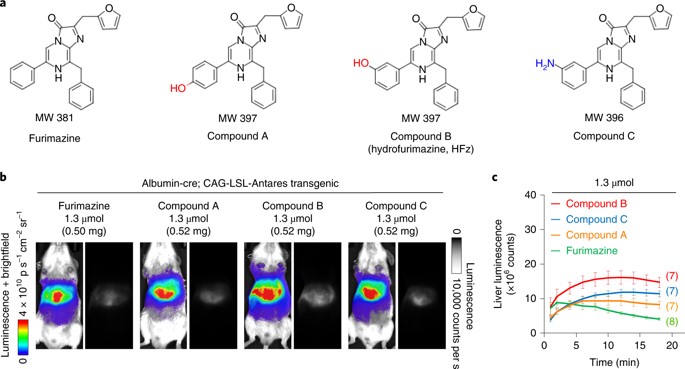2022-02-15 10:03:07
Fluorescence imaging technology with luciferase as the reporter source in vivo has the advantages of strong specificity and harmlessness to organisms, and has irreplaceable advantages in tumor metastasis research, drug development, gene therapy, etc. Luciferin or luciferase is not a specific molecule, but a general term for all substrates capable of producing fluorescence and their corresponding enzymes. The genetically engineered NanoLuc luciferase, combined with the substrate furimazine, can produce high-intensity, glow-type luminescence, and can provide high-brightness signals, playing a vital role in in vivo bioimaging.
Recently, the Michael Z. Lin group of Stanford University and Thomas A. Kirkland of Promega Bioscience and other researchers reported two new NanoLuc luciferase substrates that can be used to achieve dual-color bioluminescence imaging in mice.
The two new NanoLuc luciferase substrates are hydrofurimazin and fluorofurimazine. Researchers first developed a new substrate, hydrofurimazine, whose enhanced aqueous solubility allows delivery of higher doses to mice. In the liver, Antares with hydrofurimazine exhibited similar brightness to AkaLuc with its substrate AkaLumine. Further chemical exploration generated a second substrate, fluorofurimazine, with even higher brightness in vivo.

They used Antares with fluorofurimazine to track tumor size and AkaLuc with AkaLumine to visualize CAR-T cells within the same mice, demonstrating the ability to perform two-population imaging with these two luciferase systems.
Reference: Yichi Su, Joel R. Walker, Yunhee Park, et al. Novel NanoLuc substrates enable bright two-population bioluminescence imaging in animals. Nature Methods, 2020. DOI: 10.1038/s41592-020-0889-6
Copyright © Suzhou Yacoo Science Co., Ltd. All Rights Reserved
Friendly Links :
online service